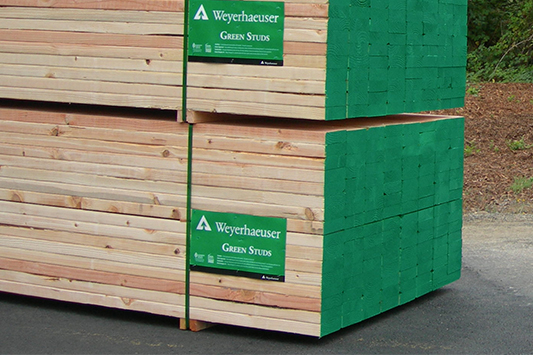With environmental realities bearing down, the construction industry is faced with both finding and implementing sustainable solutions to significantly reduce projects’ carbon footprints. According to Architecture 2030, the built environment contributes to greenhouse gas (GHG) emissions, with construction accounting for 11% and building energy operations responsible for 28% annually.
Sustainability advocates within the construction sector have long underscored the benefits of building with wood, a renewable resource with the power to reduce GHG emissions, but it’s not a simple or straightforward solution. When building with wood, kiln-dried, or seasoned, is the most common choice. High in price, kiln-dried wood has a moisture content of less than 20% and is a premiere material choice given its controllability and protection against fungal degradation. However, there is an often-overlooked alternative to kiln-dried wood that also comes with significant environmental benefits—green lumber.
What is Green Lumber?
Green lumber, or fresh cut wet lumber, does not have a chance to dry or season. It has a moisture content greater than 20%, making it most suitable for construction use in arid regions like Arizona and Southern California. While the main advantage of green lumber is its reduced environmental impact compared to kiln-dried wood, which uses fossil fuels to dry, there are additional benefits for its use in construction:
Advantages of Green Lumber
- Inexpensive: Green lumber is the cheapest raw material available, typically a fraction of the cost of kiln-dried wood. However, experience working with green lumber is needed, and while it may slash material costs, projects should not discount trade worker experience.
- Time & Money: Since green lumber bypasses the time and energy it takes to achieve kiln-dried or air-dried wood, it can be used immediately for construction.
- Flexibility: Compared to kiln-dried wood, green lumber is more malleable and will shrink as it dries. Though shrinking is often considered a drawback, it can be managed with the proper construction techniques. The key is to work and plan with the shrinkage in mind.The higher moisture content enables easier cuts and shape manipulation during construction. Assuming dry conditions, green lumber will stop shrinking within three to four months of being cut.
- Strength: Green wood does require paying extra attention to load-bearing pieces, however the malleableness of the material can result in a stronger compression lock than dry lumber.
- Global Warming Benefit: Green lumber dries naturally, cutting out the use of fossil fuels and decreasing the overall environmental impact.
Green lumber has the makings and intricacies of a high-quality construction material – with significant benefits. When properly planned for, utilized and integrated, it will not only reduce time and money but enhance sustainability and result in a strong build.

